Christopher Hector wrote the review
Tom Roberts was a pioneer of civilised riding and training in Australia, and his life and work are celebrated in a splendid little publication, Tom Roberts – Go Forward, dear, written by Andrew McLean and Nicki Stuart for Horse SA. Tom may have spent most of his life teaching in South Australia, but through his books, he spread his message world wide, a message that both Andrew and Nicki, who are heavily involved in the Equitation Science movement, recognize as being so very similar to the principles and procedures of the modern day Equitation Science.
One of the problems of theoretical equitation is that it tends to get just that – theoretical and divorced from the living breathing animal that is a horse, and the relatively simple relationship between horse and rider. This is not to deny that at the higher levels of riding in any of the disciplines, there are increasingly complex exercises and school figures, but at their base is a fairly simple and straight forward set of basic responses and a fairly simple system of aiding.
Tom Roberts’ equestrian education was basic. Enlisted in the army at the outbreak of World War One as a fourteen-year-old trumpeter, young Tom learnt the basics during his training, where he was taught to ride.
“I noticed that by good luck, or something, I seemed to have ‘a knack’ with horses…”
At the time, ‘rough riders’ were employed (at an extra six pennies a day) to train unruly troop horses. Tom was inducted into an emergency three (instead of the normal nine) month course, and in 1917 became the British Army’s youngest ever rough rider. In 1919, Tom enrolled in the Army School of Equitation Instructors Course at Weedon, lead by Major Charles ‘Taffy’ Walwyn.
Story continues below the advertisement
According to Tom it was pretty tough:
“By the end of the first week of this, the first class, about half the men accepted for the course had been returned to their units as unacceptable, ‘not up to the required standard.’ By the end of the second week most of those remaining had asked to be returned to their units. Permission was refused.”
Towards the end of the course there was a guest instructor, Capt. J. J. (Jimmy) Pearce, someone who was to have a huge influence on Tom Roberts. Pearce was a former member of Buffalo Bill’s circus, but after receiving an inheritance, decided to study classical dressage in Europe and spent several years at the Spanish School in Vienna. Captain Pearce later visited Australia in the 1950s…
After a further period of service in India, Tom Roberts migrated to South Australia, working as a labourer, and for a time, bee keeper, but he then found his vocation working with the South Australian Mounted Police. After World War II, Tom was appointed Sergeant Instructor, and soon the Police Greys became famed at Australian Horse Shows, especially as Tom had followed the Weedon example, and had his riders and horses trained to jump.
Although Tom was not able to accept any payment for outside work, he became an influential teacher in Adelaide’s horse community. Tom married his second wife, Pat in 1952, although their wedding had to be postponed for a week as it clashed with the first One Day Event in South Australia where Tom ran the dressage phase and Pat penciled for one of the judges, Captain J. J. Pearce.
Pat became a film maker, and her 8 mm films formed the basis of Tom’s instruction evenings at their home with up to 200 guest discussing a huge range of equestrian topics.
Story continues below the advertisement
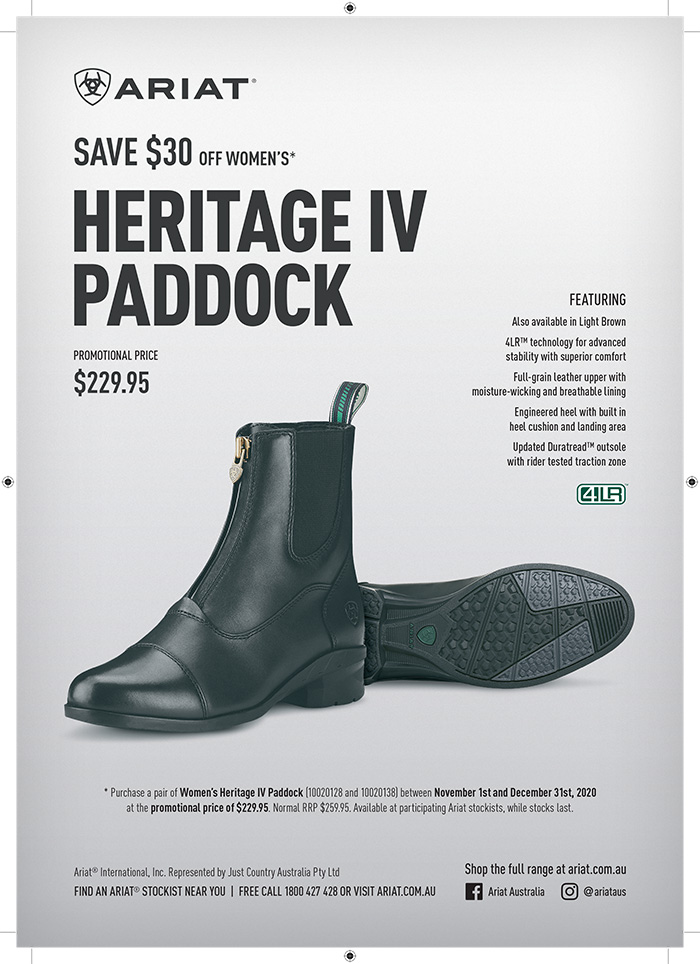
In 1950, Tom won the first Dressage Event held by an agricultural show – Adelaide, but he had also started work with his most famous pupil, Erica Taylor. Erica tells the story in the book:
“The Riding Club next door used to run a dressage competition. It might have been just at the end of the year, or something. I remember I went down for a lesson with Robbie, and then I went over, because it was on the same grounds on Greenhill road, and I went in this Dressage test: the first test I ever rode. And I won it. And I came back and said to Robbie ‘Oh wow! Robbie! I won!’, and he said, ‘Oh yes. Thought you would.’ I was flabbergasted.”
Erica went on to compete at the 1986 World Dressage Championships and the 1988 Olympic Games, where American, Robert Dover, expressed his amazement that the judges had not seen the quality of Erica (and her home-bred Thoroughbred stallion, Crown Law) and that they had (narrowly) missed out on the Special.
Some feeling for the elegant simplicity of Tom Roberts’ message may be gained from this letter that he sent to pupils before they started to have lessons with him:
“It is no use whatever aiming high until you have mastered this SIMPLE thing – Your horse must respond instantly, immediately and with appropriate energy to all pressures of the legs. Having set a pace for him, HE MUST MAINTAIN IT without constant goading by the rider. If the rider has to move his legs (increase leg pressure) it should be invisible to an onlooker.”
“You have to learn to SIT STILL and not urge the horse until he needs it – and THEN make him notice and again SIT STILL. None of you can do this and you must determine to master this trifle… This is the task I set you between this class and the next. Can you produce a horse next time that gives the onlooker the impression that he needs lightly holding rather than constant driving?… Will you have learnt to constantly attend to your horse so that you recognise IMMEDIATELY the slightest change of pace or tempo, then apply the necessary aids? And will you have taught your horse to attend and ACT INSTANTLY on the indications you give? Can you?? We’ll see!!”
The development of dressage in Australia received a post-War boost when a number of European horsemen migrated to Australia. One was the young Pole, Marian Malecki (who became an influential teacher in South Australia), the other was former Spanish Riding School rider, Franz Mairinger. Mairinger had been sponsored to migrate to Australia by R M Williams, but arrived to find the promised accommodation and position as horse trainer filled, and was working as an upholsterer and labourer while deciding whether to bring his family to Australia.
Luckily (!?) Mairinger cut his hand working on the docks, and the doctor who attended him learned of his background and put him in touch with Tom Roberts, who gave him lodgings, taught him to drive and set about finding him more suitable work. Franz Mairinger went on to be the first National Coach with the EFA until his death in 1978.
Story continues below the advertisement
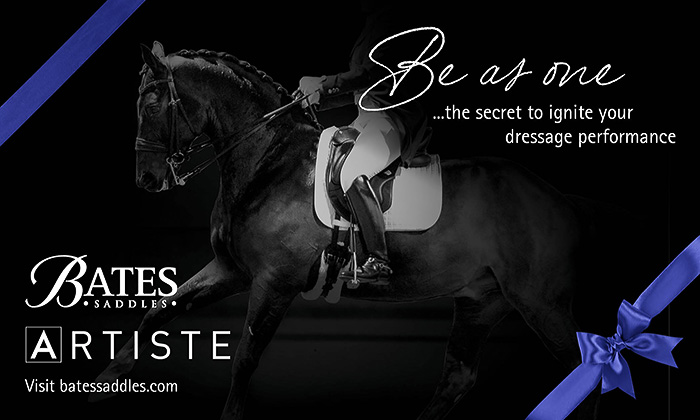
Tom’s influence was felt in all the equestrian sports: polo, showjumping, eventing, dressage and hugely in the Pony Club movement. This influence increased with the publication of Horse Control series of books. A publisher told Tom and Pat that they would be lucky to sell a 1000 copies of the first book, Horse Control and the Bit. They took the risk and in 1971, self-published 5000 copies. The first edition soon sold out and there were at least ten reprints with some runs of 5000. Tom’s next book, ‘Horse Control – The Young Horse’, published in 1974, also sold out, and required eight more editions of around 10,000 copies each.
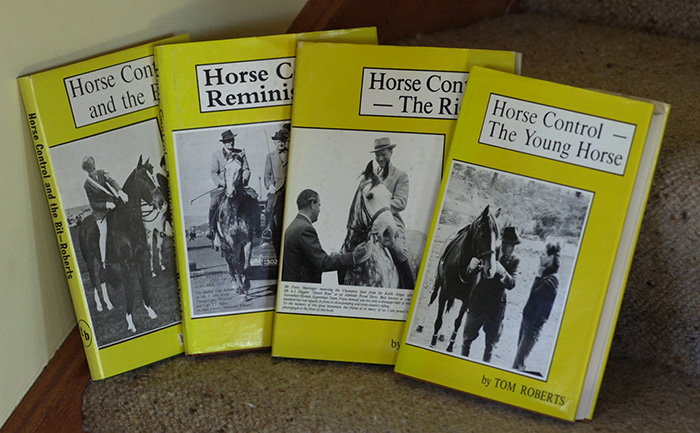
Tom’s third book, Horse Control – The Rider, features Erica Taylor training Crown Law. Again, Erica remembers with affection:
“I’ve often said that there’s not been one thing that Robbie told me that I’ve felt wasn’t right. You know years later when I’d progressed to a much higher standard (and trained with international instructors), there has never been one thing when I’ve thought, ‘Well, Robbie was wrong.’ Never, ever one thing that he wasn’t right about.”
The first section, basically a biography, written by Nicki Stuart is a joy to read. The second section, written by Andrew McLean sets out to examine Tom Roberts’ teachings in the light of equestrian science. Although I have unbounded admiration for Andrew and the multitude of ways he has made horse training more civilised and thoughtful, at times I was reminded of my undergraduate studies (politics) and a particularly tedious school of American behavouralist political ‘scientists’. They would use surveys and statistics to ‘prove’ that people who were more interested in politics were more likely to talk about politics, and vote. None of their findings were as insightful as those of the French writer, Alexis de Toqueville who travelled through the USA in the early nineteenth century, and without so much as a questionnaire or a computer laid bare the essence of American society.
Does it really add anything to claim ‘Robbie’ many years after his death as an equitation scientist? Or is it a bit like the Molière character who was amazed to discover he had been talking prose all his life? It might be more respectful to characterize the equitation ‘scientists’ as followers of Tom Roberts?
Andrew is illuminating when he discusses Tom Roberts on Negative Reinforcement:
“Tom’s deep knowledge of the workings of negative reinforcement is perhaps his greatest achievement. Very few, if any, authors have accurately encapsulated negative reinforcement as clearly as he has in his dictum ‘profit you, profit you not.’ This is truly remarkable since negative reinforcement is the major learning process of horses training. His most illuminating description of negative reinforcement is seen in his famous ‘pin’ analogy. He would ask his pupils, Why do you jump up instantly is you sit on an upturned tack or drawing pin? People would answer, Because it hurts, and Tom would reply, No, you jump up not because it hurts, but to stop it hurting! The horse learns to stop and go in the same way. Throughout Tom’s books, he constantly refers to the importance of removing the pressure: lightening the pressure of rein and leg when the horse offers the correct response. Similarly with the whip, instead of viewing it as a punishment tool he promoted the deft use of negative reinforcement where the whip is used in a rhythmic tapping motion that stops as soon as the desired response is achieved: Move forward. If you don’t then the whip will tap and worry you until you do – then it stops.”
It is in the chapter – Cues and Signals – that Andrew and I part company. Andrew approvingly quotes Baucher’s ‘reins without legs and legs without reins’ but even Baucher never reconciled this doctrine with his other technique of l’Effect d’Ensemble, Combined effect, which he never abandoned. In his famed Q & A session, Baucher is asked: Should the legs and hands act separately, or ought they assist one another? and he replies: Each of these aids should be assisted by the other.”
(The Principles of Horsemanship by F. Baucher, 1854, translated from the French by John Swire, page 88)
The idea of legs without etc, only appears for the first time in the 12th Edition of the New Way, primarily because Baucher was anxious to sell his method to the military and this was a good simple method to produce basic walk, trot and canter. For higher work, Baucher made use of the combined effect (indeed he is the pioneer of rolkur with his technique of remaner outré!)
Okay when you first ride a horse and use an opening rein to turn, or both reins to stop, or legs to go forward, you would not confuse the issue of running the aids into each other, but once the horse is starting towards collection, then it seems to me, the only way you alter the horse’s balance is by half halts and essentially a half halt is a push with the legs into a controlling contact, the horse comes more under himself, and goes to the bit and there meeting a contact, comes away from the bit. It is well expressed in Jo Hinnemann’s book, The Simplicity of Dressage:
‘Hinnemann views coming away as a sign that the horse completely accepts the bit. The horse allows of the impulsion of his hindquarters (generated by the leg, CH) to flow over his back and through his neck to a closed but ‘living’ mouth. He trusts the bit completely. At the same time, the horse lightly and almost imperceptibly comes away from the bit. The rider notices the contact become even nicer and lighter and the driving and restraining aids are optimally communicated.”
It seems to me, that if you are not allowed to increase the leg pressure in this situation, to get a result, then the only alternative is to pull back on the rein, which is always an abomination. Impulsion and a directing contact should fuse to create balance.
Andrew suggests that Tom Roberts’ pristine ‘French’ approach was confused by the Germanic teachings of Franz Mairinger and in his final two books this confusion was apparent.
“Horse Control and The Rider (1980) bears testimony to this odd mixture of equestrian ideologies. For example, he explains that: Leg aids must predominate – always, and their use must always precede the rein aids even when riding into a halt or a rein-back. Later he advises: As his training progresses, the young horse comes to recognise that although a tightening on one rein means ‘check pace and turn this way’, the use of the rider’s legs at the same time is meant to counter this stopping effect. He has to begin to weigh the effects of one aid against the other, and this weighting of one aid against the other becomes more and more important as training goes on.”
No confusion here, a brilliant exposition of the correct way to give a half halt, the basis of all advanced riding. It is in fact almost word for word the description of the same process that is found in Reiner and Ingrid Klimke’s book, Basic Training of the Young Horse.
But no, Andrew suggests that using the two aids in conjunction is ‘a travesty of animal training principles.’ And for me, that is the point at which the ‘scientific’ theory flies in the face of the reality (evidence) riders have experienced throughout the centuries, and therefore is no longer scientific. It is superstition.
It would be a dull world indeed if we agreed about everything, and I am, and all horse people should be, extremely grateful to Nicki Stuart and Andrew McLean for this thought provoking little book. Let’s finish with a tribute from Olympian – and pupil – Gill Rolton:
“My main memories of lessons with Robbie are of talking about ‘the feeling’ and I remember him holding the reins and giving me the feel of what I should be feeling thought the horse’s mouth from my hands. It was a light, soft feeling, not a heavy dead feeling. It was always a conversation in the connection. That was the main thing that I took: that I can really remember and that I still use today when teaching. It’s a conversation of the rider with the horse that is important. It’s not domination, it’s a conversation.”
“I think that Tom Roberts’ legacy is understanding. He was obviously very gifted as a rider with difficult horses, but he always had a solution to whatever problem came along. A solution which was not confronting.”
You can order one of these splendid books by going to Horse SA’s online store $29.99 plus PPH https://horse-sa.myshopify.com/

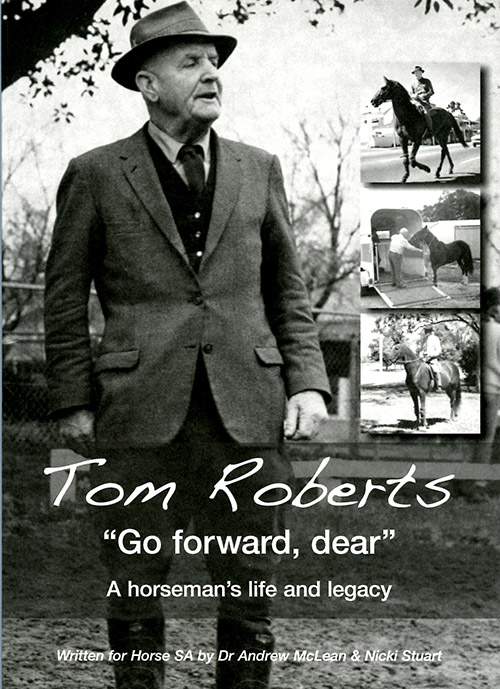
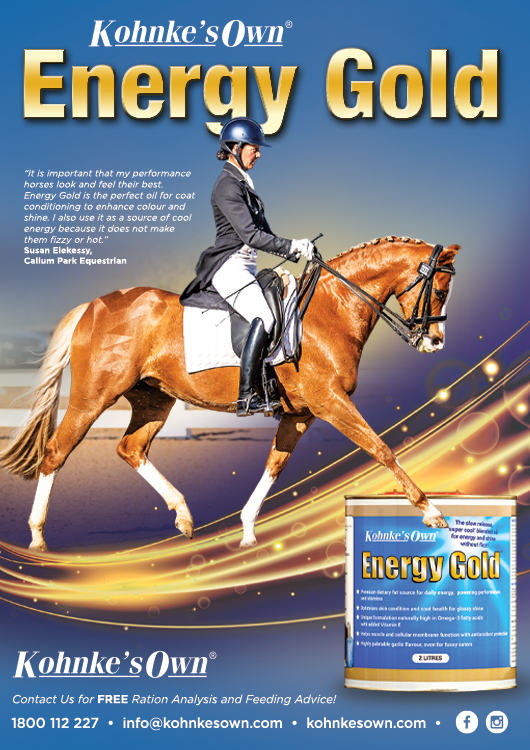
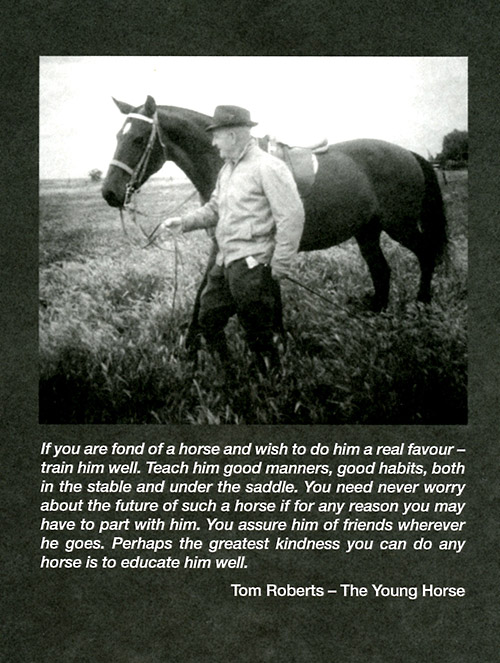
Many people respond very positively to this article and information provided but at the same time go back to poor methods in their own riding.
There is help to learn available.
My hope is that riders genuinely interested in understanding their horses better within a dialogue of finesse, source this information.
Thank you Andrew and the editor.